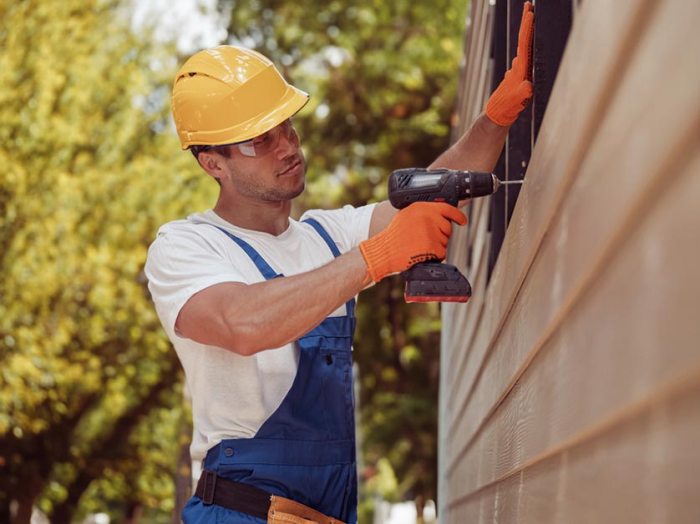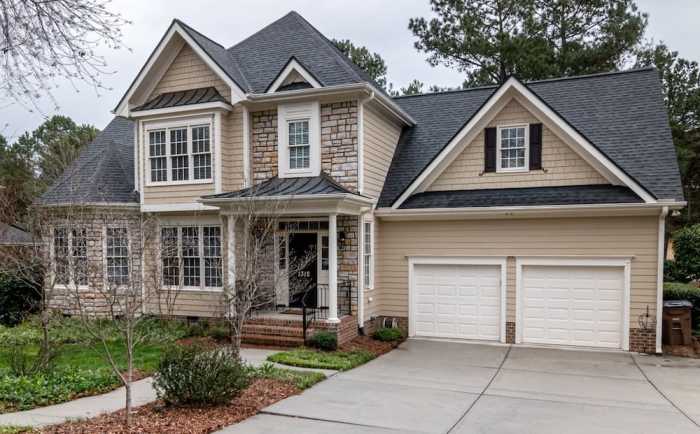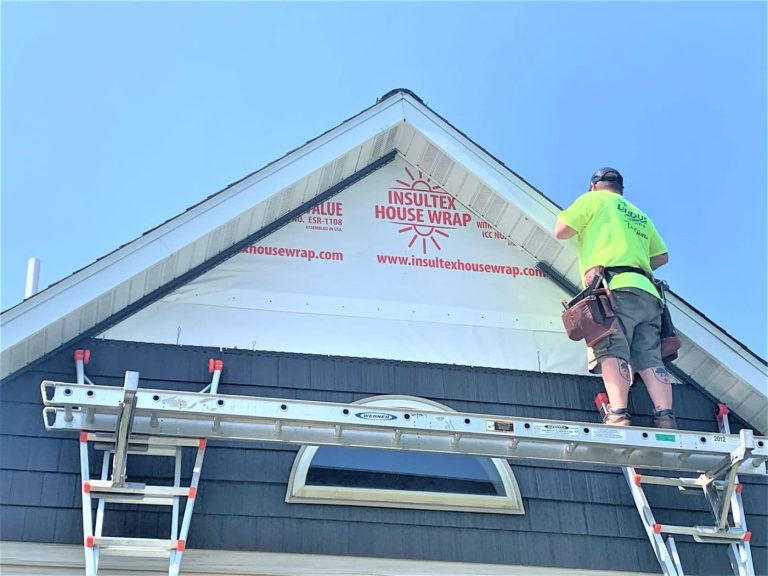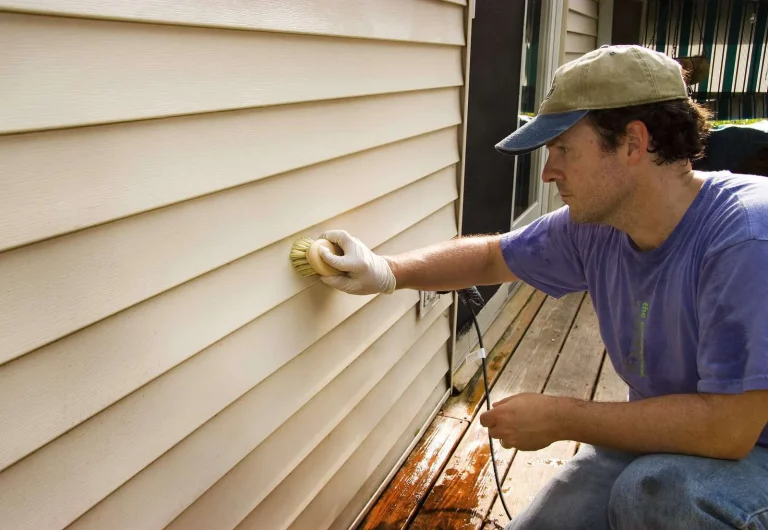Siding and Window Replacement A Comprehensive Guide
Siding and window replacement are significant home improvement projects impacting both the aesthetic appeal and energy efficiency of your property. This guide provides an in-depth exploration of the entire process, from initial assessment to final maintenance. We’ll cover various siding materials, from classic wood to modern vinyl, and delve into different window types and their characteristics. Understanding the pros and cons of each option is key to making informed decisions.
The guide will walk you through crucial planning and preparation steps, including obtaining necessary permits and choosing reliable contractors. We’ll explore the selection process for siding and window materials, highlighting factors like budget and energy efficiency. Detailed installation procedures, maintenance tips, and cost breakdowns are also included, offering a comprehensive approach to this transformative project. Finally, we’ll discuss environmental considerations and sustainable options.
Introduction to Siding and Window Replacement
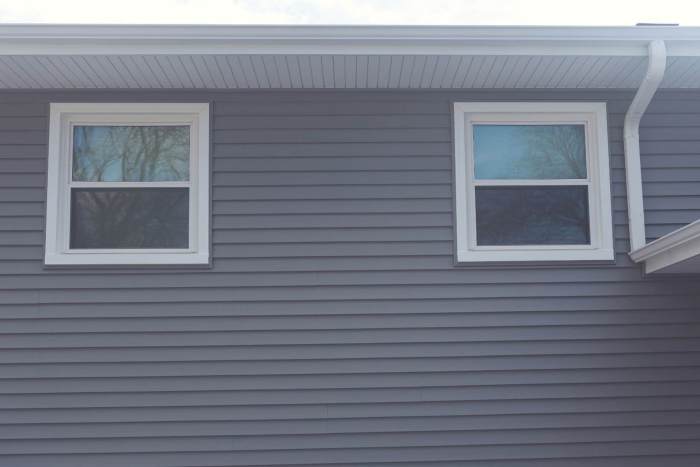
Source: ultimateviewwindows.com
Siding and window replacement projects are significant home improvement endeavors that enhance both the aesthetic appeal and energy efficiency of a property. These renovations often require careful planning, considering various materials, types, and costs to achieve optimal results. Proper selection and installation are crucial for long-term performance and value retention.
The process typically involves removing the existing siding and windows, preparing the surfaces, installing new materials, and ensuring proper sealing and finishing touches. The specific steps and timelines will vary depending on the scope of the project, the complexity of the design, and the chosen materials.
Types of Siding Materials
Different siding materials offer varying aesthetics, durability, and maintenance requirements. Understanding the characteristics of each material is essential for making informed decisions.
- Vinyl siding is a popular choice due to its affordability, low maintenance, and wide range of colors and styles. It is resistant to rot, insects, and moisture, requiring minimal upkeep.
- Wood siding, while offering a classic, natural look, demands more upkeep. It is susceptible to moisture damage, insect infestation and requires regular painting or staining. Proper sealing and maintenance are crucial for its longevity.
- Fiber cement siding provides a durable and aesthetically pleasing alternative to traditional materials. It is highly resistant to moisture, insects, and fire, offering a long lifespan with minimal maintenance.
Types of Windows
The selection of windows significantly impacts a home’s energy efficiency and aesthetic appeal. Understanding the different window types is crucial for achieving desired results.
- Double-hung windows, a common choice, allow for easy ventilation and natural light. They consist of two sashes that slide vertically, offering a classic look.
- Casement windows are known for their efficient ventilation. They open outward, providing excellent airflow and a contemporary design.
- Sliding windows are a practical option for maximizing natural light and offering easy access to the outdoors. They slide horizontally, providing a clean and streamlined appearance.
Comparison of Siding Materials
The following table provides a concise comparison of different siding materials, considering their pros, cons, and estimated costs. Note that costs can vary significantly based on location, labor costs, and specific material choices.
| Siding Material | Pros | Cons | Estimated Cost (per square foot) |
|---|---|---|---|
| Vinyl | Affordable, low maintenance, durable, wide variety of colors and styles, resistant to rot, insects, and moisture. | It can fade over time, less aesthetically pleasing than wood or fiber cement in some opinions, and less durable than fiber cement in extreme conditions. | $3-$6 |
| Wood | Classic, natural look, good insulation, can be customized to match architectural styles. | Requires regular maintenance (painting, staining), susceptible to moisture damage, insect infestation, and potential for warping. | $5-$10 |
| Fiber Cement | Durable, low maintenance, resistant to moisture, insects, and fire, long lifespan, aesthetically pleasing. | Higher initial cost, may not match all architectural styles as easily as wood. | $8-$15 |
Planning and Preparation
Careful planning and preparation are crucial for a successful siding and window replacement project. Thorough assessment of the existing structures, obtaining necessary permits and inspections, and selecting a qualified contractor are essential steps to ensure the project proceeds smoothly and efficiently. This phase lays the groundwork for a high-quality, long-lasting result.
Proper planning and preparation minimize potential problems and delays, ensuring a smoother transition from the initial assessment to the final installation. A well-structured approach allows for informed decision-making, optimal resource allocation, and a more cost-effective project execution.
Assessing Existing Siding and Windows
A thorough evaluation of the existing siding and windows is the cornerstone of a successful replacement project. This involves inspecting the condition of the materials, identifying areas of damage or deterioration, and determining the overall structural integrity. The inspection should consider the type of material, the extent of any rot, insect infestation, or moisture damage. Careful documentation of findings is vital, as it provides a baseline for comparison during the replacement process. Images and detailed notes can aid in communicating issues to the contractor and in understanding the scope of work.
Obtaining Necessary Permits and Inspections
Obtaining the necessary permits and inspections is a critical legal and regulatory step. Local building codes and regulations often require permits for siding and window replacements, ensuring that the work complies with safety standards and structural integrity requirements. Failure to obtain proper permits can result in project delays, fines, or even legal repercussions. Before commencing any work, consult with the local building department to determine the necessary permits and inspection requirements. The building department can provide specific forms, fees, and timelines associated with these procedures.
The Role of a Contractor in the Replacement Process
Selecting a qualified and reputable contractor is paramount. A skilled contractor possesses the expertise, experience, and resources to handle all aspects of the replacement project, from initial assessments to final inspections. The contractor should have a proven track record, positive customer testimonials, and adequate insurance coverage. It is important to interview potential contractors, inquire about their experience with similar projects, and review their contracts carefully before making a decision. Contractors can provide detailed cost estimates, timelines, and warranties, helping in making an informed choice.
Pre-Replacement Preparations Checklist
A well-organized checklist streamlines the pre-replacement phase, ensuring all critical steps are addressed. This structured approach minimizes potential issues and keeps the project on schedule. The checklist should encompass several key areas:
- Site Preparation: This includes clearing the area, protecting landscaping, and securing necessary access points. Ensuring the work area is accessible for equipment and materials is essential for a smooth workflow.
- Material Procurement: Securing the necessary siding and window materials at the appropriate time is critical. This process involves selecting the right materials based on budget, aesthetic preferences, and durability requirements. Ordering in advance allows for potential delays or shortages to be managed efficiently.
- Documentation: Detailed documentation of the existing conditions, including measurements, photographs, and notes, is critical. This documentation aids in communication with the contractor, ensures accurate estimates, and serves as a record of the project.
- Permitting and Inspections: Ensure that all necessary permits and inspections are obtained from the local building department. This step ensures compliance with local regulations and avoids potential legal issues. Knowing the exact process and required documents beforehand is critical.
- Contractor Selection: Thoroughly research and select a qualified contractor with experience and a proven track record in siding and window replacement. Requesting references and checking their insurance coverage is important.
Choosing Materials and Professionals
Selecting the right siding and windows is crucial for a successful project. Careful consideration of materials and the choice of qualified professionals directly impact the longevity, energy efficiency, and aesthetic appeal of your home improvement. Understanding the various options available allows homeowners to make informed decisions, aligning with their budget and desired outcome.
Siding Material Selection
Different siding materials offer unique benefits and drawbacks. Factors like budget, desired aesthetic, climate, and maintenance requirements influence the optimal choice. Wood siding, for example, provides a classic look but demands regular upkeep. Vinyl siding is a low-maintenance alternative, while fiber cement siding offers durability and a natural appearance, although it can be more expensive. Consider these factors when making your selection:
- Budget: Pricing varies significantly between materials. Vinyl siding generally falls on the lower end, while fiber cement siding is often the most expensive option.
- Maintenance: Some materials require more upkeep than others. Wood siding needs regular sealing and painting, while vinyl siding is virtually maintenance-free.
- Aesthetics: Consider the architectural style of your home and the overall aesthetic you’re aiming for when choosing siding.
- Climate: Local climate conditions can influence the suitability of different siding materials. Areas with high humidity might favor vinyl or fiber cement over wood, for example.
Window Material Selection
Choosing the right window materials involves a similar consideration of budget, energy efficiency, and aesthetics. Double-paned windows, often with low-E coatings, are a common choice for energy efficiency. Casement, awning, and sliding windows each offer distinct advantages in terms of operation and appearance. Energy efficiency ratings and warranty information should be carefully evaluated.
- Energy Efficiency: Look for windows with high energy efficiency ratings, which translate to lower heating and cooling costs. Low-E coatings and multiple panes are key factors to consider.
- Warranty: Warranties vary between window brands and types. A comprehensive warranty can provide peace of mind and protect your investment.
- Operation: Consider the type of operation you prefer – casement, awning, sliding, or double-hung – based on your lifestyle and the specific needs of your home.
- Aesthetics: Match the window style to the overall design of your home for a cohesive look.
Contractor Evaluation Criteria
Evaluating contractors and subcontractors is crucial to ensure a high-quality installation. Look for established companies with a strong reputation, excellent reviews, and a proven track record. References and past projects are essential indicators of a company’s competence. Check for licensing, insurance, and bonding to ensure they operate legally and responsibly.
- Reputation and Reviews: Check online reviews and testimonials from previous clients to gauge the contractor’s performance.
- Licensing and Insurance: Verify that the contractor holds the necessary licenses and carries adequate liability insurance.
- References: Request references from previous clients to gain insights into the contractor’s work ethic and reliability.
- Experience: Look for contractors with significant experience in siding and window replacement, especially in your specific region.
Window Warranty Comparison
Window warranties often differ in coverage, duration, and specific conditions. Lifetime warranties may offer the greatest peace of mind, but they may come with specific limitations or exclusions. Extended warranties might be a good option for a balanced approach. Manufacturer warranties are typically tied to the specific product and the installation process.
Window Brand Comparison
| Window Brand | Features | Energy Efficiency Rating | Warranty |
|---|---|---|---|
| Pella | Known for quality construction, diverse styles, and energy-efficient options. | Generally high, often exceeding industry standards. | Typically includes a comprehensive lifetime warranty with specific conditions. |
| Anderson | Renowned for durability, energy efficiency, and a wide selection of window styles. | High energy efficiency ratings, often exceeding industry standards. | Usually includes a lifetime warranty with specific limitations and exclusions. |
| Marvin | Focuses on craftsmanship, customization, and energy efficiency with a wide range of window styles. | Generally high, with various options to meet specific needs. | Offers comprehensive lifetime warranties with particular conditions. |
| Renewal by Andersen | Offers a variety of styles and features, aiming for value and energy efficiency. | Good energy efficiency ratings, comparable to other leading brands. | Typically provides a limited lifetime warranty with specific terms. |
Installation Process
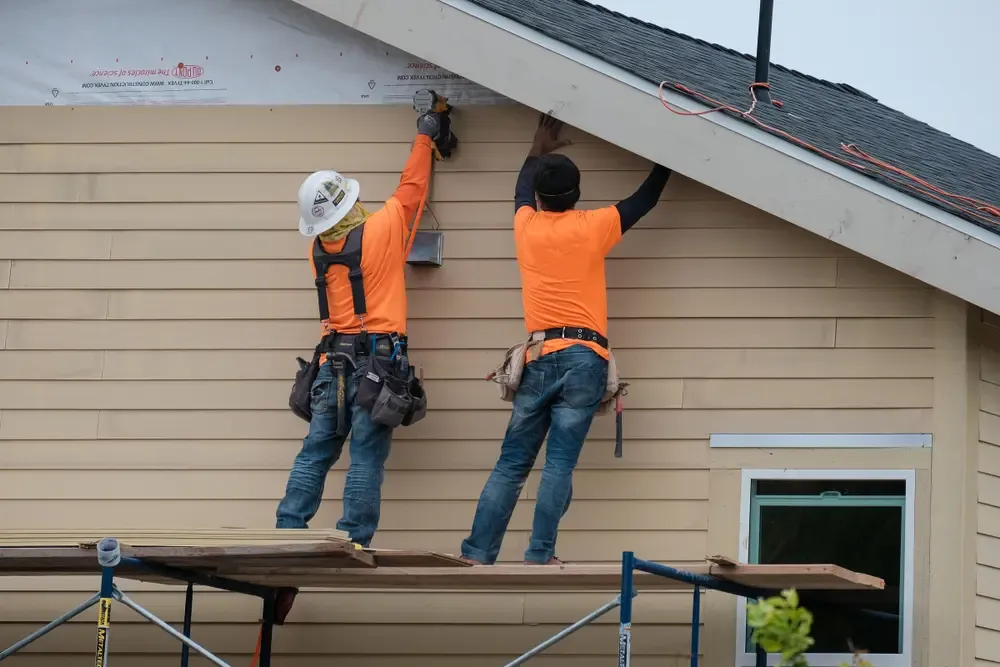
The installation phase is crucial for the longevity and performance of your new siding and windows. Proper installation ensures a weather-tight seal, maximizing energy efficiency and minimizing future maintenance needs. Careful execution of each step is essential to achieve a quality result.
The installation process, while seemingly straightforward, requires precision and expertise. Contractors typically use specialized tools and techniques to ensure a secure and aesthetically pleasing fit. Understanding the procedures involved helps homeowners anticipate the timeline and potential challenges.
Siding Installation Steps
Careful preparation is paramount before siding installation. This includes ensuring the existing structure is sound and properly prepared to receive the new siding. A thorough inspection of the existing structure is critical to avoid future issues.
- Surface Preparation: Inspect the existing framing for any damage, rot, or loose nails. Repair or replace any damaged sections to ensure a solid foundation for the new siding. Clean the existing surface thoroughly to remove debris and loose material, ensuring a proper adhesive bond. This crucial step often determines the longevity of the installation.
- Installation of Flashing and Trim: Flashing and trim are crucial components for preventing water damage. Properly installed flashing directs water away from the siding, preventing leaks and rot. Trim pieces provide a finished look and protect the edges of the siding.
- Siding Application: The new siding panels are installed according to the manufacturer’s instructions. Careful attention to overlap, spacing, and fastening methods is vital. Using appropriate fasteners and ensuring proper alignment across the entire surface are key to a successful installation.
- Final Inspection: A final inspection ensures all gaps are sealed, flashing is properly positioned, and the siding is secure. This step is crucial for detecting any potential issues before the project is completed. Any defects found at this stage are addressed promptly.
Window Installation Steps
Window installation is a complex process requiring careful attention to detail. Proper installation ensures the window seals effectively, preventing drafts and energy loss.
- Preparation for Installation: The existing window frame needs to be removed carefully. The new window frame should be carefully measured and prepared before installation. Pre-installation preparation prevents costly mistakes during the installation.
- Framing and Installation: The new window frame is installed in the prepared opening. This step requires precision and adherence to the manufacturer’s guidelines. Accurate measurements are essential to ensure a proper fit.
- Weatherstripping and Sealing: Weatherstripping is critical for preventing drafts and moisture intrusion. Proper sealing around the window frame prevents air leaks and enhances energy efficiency. High-quality weatherstripping is vital to ensure the effectiveness of the seal.
- Final Checks: A thorough final check is conducted to ensure the window operates smoothly, is properly sealed, and meets all safety requirements. This step is essential to verify the integrity of the installation and address any issues before the project is completed.
Common Installation Issues and Troubleshooting
Addressing potential problems proactively during the installation process minimizes costly repairs later. Prompt identification and resolution of issues are crucial.
- Leaks and Drafts: Leaks and drafts often arise from improperly sealed windows or siding. Carefully inspecting the seals and tightening any loose fasteners can prevent such issues.
- Alignment Issues: Misalignment of siding or windows can compromise the aesthetic appeal and structural integrity. Accurate measurements and proper support are essential to ensure alignment.
- Moisture Intrusion: Improper installation of flashing and trim can lead to moisture intrusion, causing damage to the structure. Careful attention to flashing and caulking is critical.
Importance of Proper Insulation and Sealing, Siding and Window Replacement
Proper insulation and sealing significantly enhance energy efficiency and reduce utility costs. High-quality materials and meticulous installation are essential.
- Energy Efficiency: Proper insulation reduces heat transfer, keeping the interior temperature consistent and minimizing energy consumption.
- Moisture Control: Sealing prevents moisture from entering the structure, reducing the risk of mold, mildew, and rot.
- Comfort: Proper insulation and sealing contribute to a more comfortable indoor environment by maintaining a stable temperature.
Clean Installation Site Procedure
Maintaining a clean installation site is essential for efficient work and minimizes potential hazards. A clean workspace allows for clear communication and efficient collaboration.
- Clear the Area: Remove all unnecessary materials and debris from the work area. This step is crucial for a safe and productive work environment.
- Maintain Organization: Organize materials and tools effectively to minimize delays and improve safety.
- Proper Disposal: Dispose of waste materials appropriately, following local regulations.
Maintenance and Care
Proper maintenance significantly extends the lifespan of your siding and windows, ensuring they remain attractive and functional for years to come. Ignoring upkeep can lead to premature deterioration, increasing repair costs, and reducing the overall value of your home. This section details crucial steps for maintaining your siding and windows, encompassing preventative measures and corrective actions for minor issues.
Preventing Damage from Weather and Pests
Regular inspection is key to identifying potential problems before they escalate. Weather conditions, including extreme temperatures, heavy rainfall, and strong winds, can cause damage to siding and windows. Pests, such as termites, rodents, and insects, can also compromise the structural integrity of these components. Implementing preventative measures minimizes the risk of significant damage.
- Protecting from Weather: Regularly inspect your siding and windows for any signs of damage, such as cracks, gaps, or warping. Seal any gaps or cracks promptly with appropriate caulking or sealant. Ensure proper drainage around your home’s foundation to prevent water from accumulating near the siding or windows. Use weatherstripping to minimize drafts and prevent water infiltration.
- Pest Prevention: Inspect your home’s exterior regularly for signs of pest activity. Check for holes, cracks, or damaged areas that could provide entry points for pests. Consider using pest-control measures to deter pests from infesting your home. Repair any damage promptly to eliminate harboring areas.
Importance of Regular Cleaning and Inspection
Regular cleaning and inspection are crucial for maintaining the aesthetic appeal and structural integrity of your siding and windows. A clean exterior enhances curb appeal and helps prevent the accumulation of debris that could contribute to damage.
- Cleaning Frequency: Clean your siding and windows at least twice a year, or more frequently if necessary, depending on environmental conditions. Cleaning helps remove dirt, grime, and mold that can degrade the materials over time.
- Inspection Schedule: Conduct thorough inspections of your siding and windows at least quarterly. Look for signs of damage, such as cracks, gaps, or loose components. Inspect for water damage, which can lead to significant issues over time.
Addressing Minor Repairs
Addressing minor repairs promptly prevents them from escalating into major problems. This proactive approach minimizes long-term damage and ensures the longevity of your siding and windows.
- Identifying Minor Issues: Look for signs of damage, such as loose or cracked caulking, peeling paint, or warped wood. Pay close attention to areas where water can accumulate or where pests might be present.
- Repair Procedures: Use appropriate repair materials, such as caulk, wood filler, or paint, to address minor issues. Consult a professional if the repair requires specialized skills or materials. For example, if a window frame is showing signs of significant rot, a professional may be necessary for effective repair.
Cost and Budgeting: Siding And Window Replacement
Home improvement projects like siding and window replacement can be significant investments. Understanding the associated costs and factors that influence them is crucial for effective budgeting and planning. Thorough research and careful consideration of different options can help homeowners make informed decisions.
Typical Cost Ranges
Siding and window replacement projects vary widely in cost, depending on several factors. A basic vinyl siding replacement for a 1,500 square foot home might cost between $5,000 and $10,000. Window replacements can range from $3,000 to $15,000 or more, depending on the number of windows, type of frame, and features like energy-efficient glass. It’s important to remember these are just estimates, and actual costs will vary.
Factors Influencing Cost
Several factors significantly affect the total cost of siding and window replacement projects. These include material costs, labor expenses, and project complexity.
- Material Costs: Different materials have varying price points. Vinyl siding is typically more affordable than fiber cement, while high-performance, energy-efficient windows can command a premium compared to standard models. The quantity of material required directly impacts the cost.
- Labor Costs: Labor costs are substantial and can vary considerably between contractors. Factors such as the contractor’s experience, location, and demand can influence the hourly or project rates. The complexity of the project also plays a role. Installing complex window configurations or intricate siding designs will typically increase labor costs.
- Project Complexity: The size of the home, the number of windows or siding panels to be replaced, and the presence of unique architectural features all contribute to project complexity. Homes with multiple stories or challenging architectural details often require more labor and specialized expertise, increasing the overall cost.
Sample Budget Breakdown
A sample budget breakdown for a moderate-sized home siding and window replacement project might look like this:
| Category | Estimated Cost |
|---|---|
| Siding Materials | $4,000 |
| Window Materials | $6,000 |
| Labor (Siding) | $2,500 |
| Labor (Windows) | $3,000 |
| Permitting and Inspections | $500 |
| Contingency Fund | $1,000 |
| Total Estimated Cost | $17,000 |
Note that this is a sample, and individual costs may differ. The contingency fund accounts for unforeseen expenses that might arise during the project.
Comparing Quotes
Comparing quotes from different contractors is essential for securing the best possible value. Carefully review the details provided by each contractor. This includes:
- Detailed Material Lists: Ensure the materials listed are appropriate for the job and align with your desired budget and specifications.
- Labor Costs Breakdown: Request a detailed breakdown of labor costs, including hours and rates for different tasks.
- Project Timeline: Understand the projected timeline for completion and potential delays.
- Warranty Information: Review any warranties offered on materials and labor to understand your protection against potential issues.
- Additional Costs: Inquire about any potential additional costs, such as permits or site preparation.
By meticulously comparing quotes and understanding the factors that influence costs, homeowners can make informed decisions about their siding and window replacement projects.
Environmental Impact
Choosing siding and windows with an eye towards sustainability is increasingly important. The environmental footprint of these materials, from manufacturing to disposal, can significantly impact our planet. This section explores the environmental impact of various materials, highlights energy-efficient options, and underscores the crucial role of responsible recycling.
Siding Material Impact
Different siding materials have varying environmental impacts. Wood siding, for example, comes from forests, and its sustainability depends on responsible forestry practices. Vinyl siding is a popular choice due to its low maintenance and durability, but its production requires energy. Fiber cement siding offers a good balance, but its manufacturing process involves chemical inputs. Each option has a different environmental trade-off.
Window Material Impact
Windows, like siding, have a significant environmental impact throughout their lifecycle. Double-pane windows, often constructed with low-emissivity (low-e) coatings, are highly energy-efficient, reducing heat transfer and minimizing energy consumption. Aluminum windows are lightweight and durable, but require considerable energy for production. Wood windows, derived from sustainably managed forests, can be a more environmentally friendly option. The specific material and manufacturing process greatly influence the environmental footprint.
Energy-Efficient Options
Energy-efficient windows and siding are crucial for reducing energy consumption. High-performance windows, equipped with low-e coatings and multiple panes, dramatically improve insulation. Similarly, siding materials with high insulation values, such as insulated vinyl or fiber cement, can help lower heating and cooling needs. Installing these energy-efficient products directly contributes to lower carbon emissions and a reduced environmental footprint. For example, a well-insulated home using energy-efficient windows can reduce energy bills by 10-20% in some regions.
Recycling Old Materials
Recycling old siding and windows is crucial for minimizing waste and conserving resources. Many materials, including vinyl, aluminum, and some types of wood, can be recycled, reducing the need for new material extraction. Proper disposal and recycling procedures help recover valuable materials for reuse, and this process significantly lowers the environmental impact of siding and window replacement projects. For instance, local recycling centers often have specific guidelines on how to properly recycle different materials.
Sustainable Practices
Sustainable practices in siding and window replacement projects involve more than just material selection. Using recycled content in new products, opting for locally sourced materials, and implementing responsible manufacturing processes are crucial components of sustainable practices. A homeowner can choose siding or windows made from recycled materials, minimizing the demand for virgin materials. Choosing windows with high energy efficiency ratings reduces energy use, lowering carbon emissions. Furthermore, careful planning and efficient installation practices minimize waste.
VisualRepresentationsn
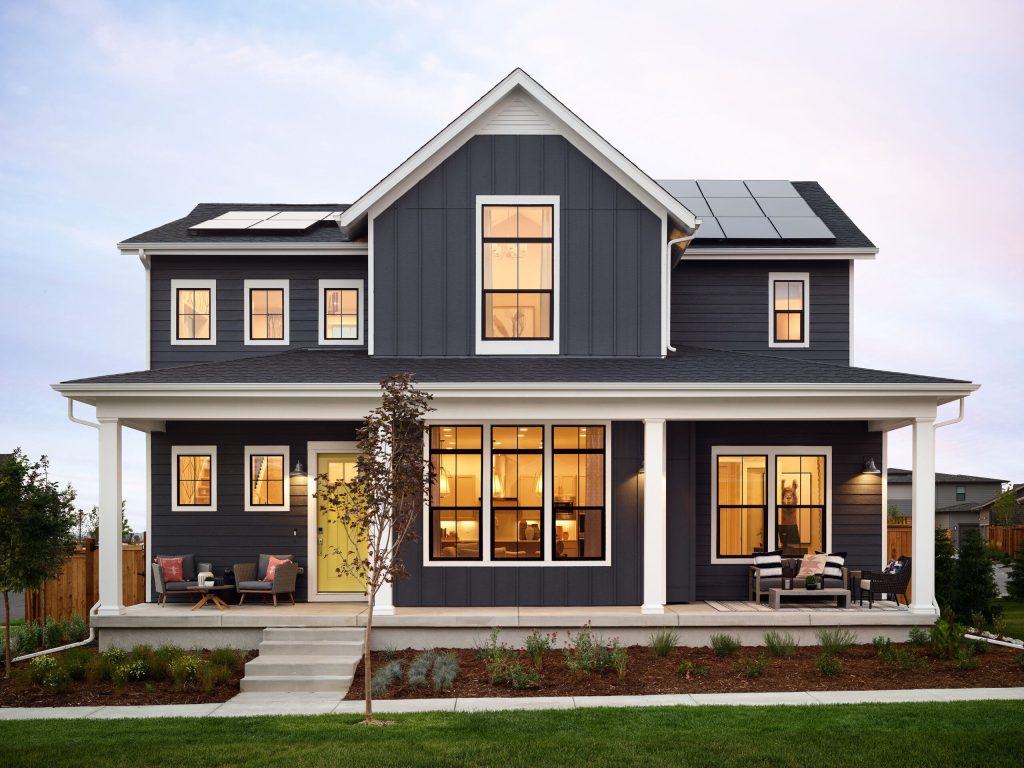
Transforming your home’s exterior involves more than just function; it’s about aesthetics. The visual impact of siding and window combinations significantly affects curb appeal and the overall style of your home. Careful consideration of these elements is crucial for achieving a cohesive and pleasing look.
A well-chosen combination of siding and windows can dramatically enhance the visual appeal of your home, reflecting its architectural style and personal taste. This section delves into the various ways to achieve this visual harmony, showcasing examples, and providing a method for generating design inspiration.
Different Siding and Window Combinations
Different siding and window materials offer a wide range of visual possibilities. The interplay between these elements can create distinct architectural styles. For example, a traditional craftsman-style home might pair cedar siding with double-hung windows in a light wood frame, while a contemporary design might utilize smooth stucco siding with modern vinyl windows in a dark frame.
Design Styles and Corresponding Materials
The architectural style of your home greatly influences the optimal siding and window combinations. Here are a few examples:
- Traditional Homes: These often feature wood siding, such as clapboard or shingles, paired with traditional double-hung windows, often with wood or composite frames. The windows might include decorative grids or transoms.
- Contemporary Homes: Contemporary homes typically use materials like vinyl siding, fiber cement siding, or stucco. They often feature large windows with minimal frames in a variety of materials such as aluminum or vinyl.
- Modern Homes: Modern homes often incorporate smooth stucco or metal siding with large, expansive windows, sometimes with minimal or no visible frames. The use of glass can be extensive, further emphasizing the modern design.
- Craftsman Homes: These homes often feature wood siding (like cedar shingles or clapboard) in a warm color palette. The windows are usually smaller, with decorative details like multiple panes or wood frames in the same color as the siding.
Creating a Mood Board for Design Inspiration
A mood board is a visual representation of your design aspirations. It helps to visualize the overall aesthetic and guide your choices.
- Gather Inspiration: Collect images of homes, siding, and windows that appeal to you. Magazines, online resources, and even photos of houses in your neighborhood can provide inspiration. Look for features like window placement, window size, and siding textures that you like.
- Choose a Medium: A physical mood board using paper, magazines, and paint swatches is effective. Digital tools, such as Pinterest, are also excellent for creating and organizing your ideas.
- Organize Your Ideas: Arrange the images on your chosen medium, grouping similar elements. This will allow you to see how various siding and window combinations can create the desired look. Consider color palettes, textures, and architectural styles.
- Refine Your Design: As you add images to your mood board, refine your vision. This iterative process will help you to visualize the final result and ensure all elements are cohesive and aesthetically pleasing.
Example Mood Board Elements
Here are a few examples of elements that you can include in a mood board for siding and window replacement:
| Element | Description |
|---|---|
| Siding Material | Examples include wood, vinyl, fiber cement, stucco, and metal. |
| Window Style | Examples include double-hung, casement, awning, and picture windows. |
| Window Frame Material | Examples include wood, vinyl, aluminum, and fiberglass. |
| Color Palette | Examples include warm, cool, and neutral tones. |
| Architectural Style | Examples include traditional, modern, craftsman, and contemporary. |
Last Point
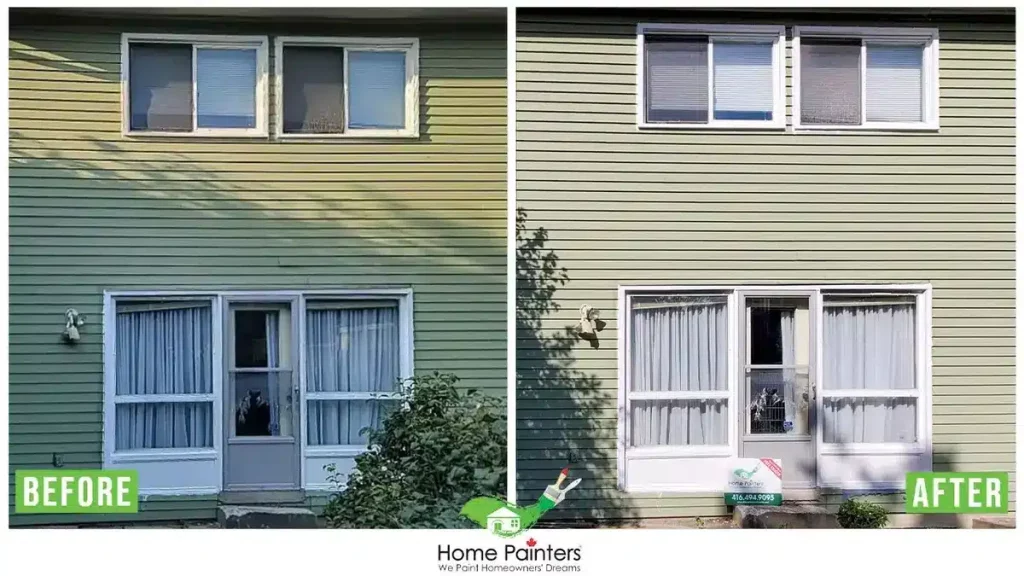
In conclusion, replacing siding and windows is a significant undertaking, but with careful planning, research, and execution, you can achieve a beautiful, energy-efficient, and long-lasting result. This comprehensive guide provides a solid foundation for navigating the entire process, from initial assessment to final maintenance. Remember to prioritize your needs and budget, research thoroughly, and choose reputable professionals to ensure a successful and rewarding outcome. By considering all aspects of the project, from materials to environmental impact, you can confidently embark on your home improvement journey.
